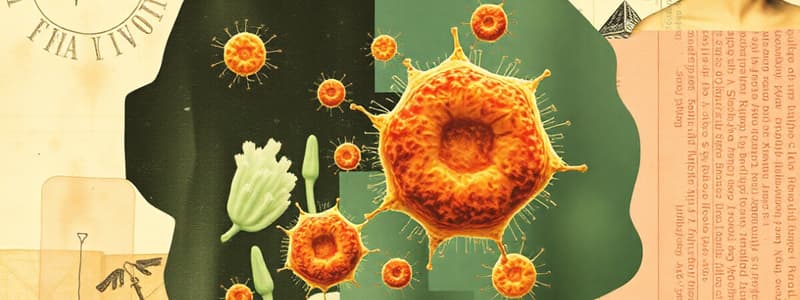Podcast
Questions and Answers
What is the primary function of enzymes in biochemical reactions?
What is the primary function of enzymes in biochemical reactions?
- To change the products of the reaction
- To increase the activation energy
- To act as biological catalysts (correct)
- To provide energy for the reaction
Which enzyme is specifically responsible for the hydrolysis of starch?
Which enzyme is specifically responsible for the hydrolysis of starch?
- Pancreatin
- Amylase (correct)
- Catalase
- Lipase
Which of the following enzymes catalyzes the decomposition of hydrogen peroxide?
Which of the following enzymes catalyzes the decomposition of hydrogen peroxide?
- Protease
- Lipase
- Catalase (correct)
- Amylase
What is pancreatin composed of?
What is pancreatin composed of?
Which statement about enzymes is correct?
Which statement about enzymes is correct?
What is the main purpose of Benedict's test?
What is the main purpose of Benedict's test?
Which of the following statements is true regarding Tollen's test?
Which of the following statements is true regarding Tollen's test?
How does Barfoed's test differ from Benedict's test?
How does Barfoed's test differ from Benedict's test?
What distinguishes Picric acid test from other sugar tests?
What distinguishes Picric acid test from other sugar tests?
In what way do aldehydes differ from ketones according to their reactivity in Tollen's test?
In what way do aldehydes differ from ketones according to their reactivity in Tollen's test?
What distinguishes monosaccharides from disaccharides?
What distinguishes monosaccharides from disaccharides?
What is the primary source of energy for the body's cells?
What is the primary source of energy for the body's cells?
Which statement regarding disaccharides is accurate?
Which statement regarding disaccharides is accurate?
Which of the following is a common example of a disaccharide?
Which of the following is a common example of a disaccharide?
What is the role of galactose in the human body?
What is the role of galactose in the human body?
How many monosaccharide units are typically found in oligosaccharides?
How many monosaccharide units are typically found in oligosaccharides?
What type of bond connects the monosaccharide units in maltose?
What type of bond connects the monosaccharide units in maltose?
Which of the following statements is true regarding fructose?
Which of the following statements is true regarding fructose?
What reaction occurs in Seliwanoff’s test to differentiate between ketohexoses and aldohexoses?
What reaction occurs in Seliwanoff’s test to differentiate between ketohexoses and aldohexoses?
Which sugar is classified as a reducing sugar?
Which sugar is classified as a reducing sugar?
What is the glycosidic bond type in lactose?
What is the glycosidic bond type in lactose?
What kind of sugar is sucrose classified as?
What kind of sugar is sucrose classified as?
What type of crystal does maltose produce when reacted with phenylhydrazine?
What type of crystal does maltose produce when reacted with phenylhydrazine?
In the reaction with phenylhydrazine, what do ketoses and aldoses produce?
In the reaction with phenylhydrazine, what do ketoses and aldoses produce?
What does the phloroglucinol-HCl test specifically detect in a sample solution?
What does the phloroglucinol-HCl test specifically detect in a sample solution?
What distinguishes the osazones produced from glucose and fructose in terms of crystal shape?
What distinguishes the osazones produced from glucose and fructose in terms of crystal shape?
What makes lactose a significant component in human and cow's milk?
What makes lactose a significant component in human and cow's milk?
What color change indicates the presence of reducing sugars in the Fehling's test?
What color change indicates the presence of reducing sugars in the Fehling's test?
What is the principle of Molisch's test for carbohydrates?
What is the principle of Molisch's test for carbohydrates?
What is formed during the reduction of alkaline cupric hydroxide in the presence of reducing sugars?
What is formed during the reduction of alkaline cupric hydroxide in the presence of reducing sugars?
In Moore’s test, how is the presence of carbohydrates determined?
In Moore’s test, how is the presence of carbohydrates determined?
What is the role of concentrated sulfuric acid in Molisch's test?
What is the role of concentrated sulfuric acid in Molisch's test?
What other tests can specifically be used to detect sugars besides the phloroglucinol-HCl test?
What other tests can specifically be used to detect sugars besides the phloroglucinol-HCl test?
What usually indicates a positive result in the Seliwanoff’s test?
What usually indicates a positive result in the Seliwanoff’s test?
Which test involves the use of concentrated H2SO4 to hydrolyze disaccharides into monosaccharides?
Which test involves the use of concentrated H2SO4 to hydrolyze disaccharides into monosaccharides?
What occurs during Nylander's test when it reacts with reducing sugars?
What occurs during Nylander's test when it reacts with reducing sugars?
Which of the following describes a key characteristic of picric acid?
Which of the following describes a key characteristic of picric acid?
Which test is similar to Trommer’s test and is specifically designed for detecting reducing sugars?
Which test is similar to Trommer’s test and is specifically designed for detecting reducing sugars?
What is a common property of all reducing sugars tested in the provided methods?
What is a common property of all reducing sugars tested in the provided methods?
Which test utilizes bismuth subnitrate as a reagent?
Which test utilizes bismuth subnitrate as a reagent?
Which of the following tests would MOST likely produce a color change indicative of maltose presence?
Which of the following tests would MOST likely produce a color change indicative of maltose presence?
What is a main factor that differentiates Trommer’s test from Benedict's test?
What is a main factor that differentiates Trommer’s test from Benedict's test?
Flashcards are hidden until you start studying
Study Notes
Enzymes
- Enzymes are proteins that act as biological catalysts.
- Enzymes lower the activation energy of chemical reactions.
Amylase
- Amylase is an enzyme that breaks down starch into simple sugars.
- Amylase catalyzes hydrolysis of starch.
Catalase
- Catalase is a common enzyme found in most living organisms exposed to oxygen.
- Catalase breaks down hydrogen peroxide into water and oxygen.
Pancreatin
- Pancreatin is a mixture of digestive enzymes.
- Pancreatin is produced by the pancreas.
- Contains amylase, lipase, and protease.
Carbohydrate Classification
- Carbohydrates are classified into four groups: monosaccharides, disaccharides, oligosaccharides, and polysaccharides.
- Monosaccharides are simple sugars, consisting of one sugar unit.
- Disaccharides are composed of two monosaccharide units.
- Oligosaccharides contain a few monosaccharide units, typically 2 to 10.
- Polysaccharides are polymers of simple sugars with more than 10 monosaccharide units.
Common Monosaccharides
- Glucose is the main blood sugar and the primary energy source for cells.
- Galactose is an isomer of glucose, known as "brain sugar" for its role in infant brain development.
- Fructose is a fruit sugar, the sweetest naturally occurring carbohydrate, and the simplest ketose.
Disaccharides
- Disaccharides are formed when two monosaccharides are linked by an acetal bond.
- Maltose is composed of two glucose units linked by an α(1-4) glycosidic bond, found in malt, the juice from germinated barley, and other cereal grains.
- Lactose, the primary sugar in milk, is composed of galactose and glucose linked by a β(1-4) glycosidic bond.
- Sucrose, or table sugar, is composed of fructose and glucose linked by a β(2-1) glycosidic bond.
Carbohydrate Tests
- Seliwanoff's Test differentiates ketohexoses from aldohexoses. Ketohexoses react faster with concentrated HCl to form furfural derivatives, which form deep red complexes with resorcinol.
- Phenylhydrazine Reaction involves reaction with phenylhydrazine to form a phenylhydrazone. Aldoses and ketoses produce needle-shaped yellow osazone crystals.
- Phloroglucinol-HCl Test uses concentrated HCl to form furfural derivatives, specifically identifying galactose and lactose.
General Carbohydrate Tests
- Molisch Test is a general test for carbohydrates. α-Naphthol reacts with furfural or its derivatives from sugar dehydration in concentrated sulfuric acid, producing a colored product.
- Moore's Test detects carbohydrates in the presence of concentrated alkali.
Reduction Tests
- Fehling's Test uses alkaline cupric hydroxide. Reducing sugars reduce it to yellow or red cuprous oxide, indicating their presence.
- Benedict's Test is similar to Fehling's, but uses different reagents.
- Tollen's Test (Silver Mirror Test) distinguishes aldehydes from ketones due to aldehydes' easier oxidation.
- Barfoed's Test oxidizes monosaccharides but not disaccharides, useful for distinguishing them.
- Trommer's Test involves acid hydrolysis of disaccharides to form monosaccharides, similar to Benedict's.
- Nylander's Test uses bismuth subnitrate, which forms a black precipitate with reducing sugars.
- Picric Acid Test uses picric acid to react with reducing sugars, forming a mahogany red solution.
Studying That Suits You
Use AI to generate personalized quizzes and flashcards to suit your learning preferences.




